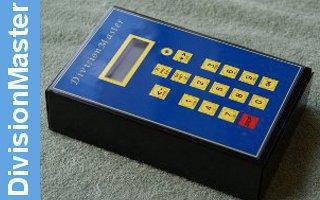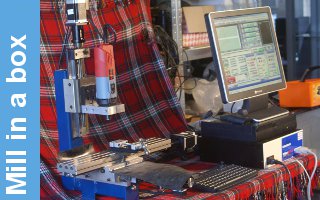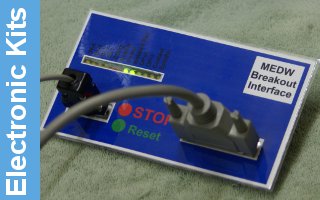HRP Hornplate
These two major components should never be considered separately in any of the traction type models, since it is essential that these two items are fitted together to maintain absolutely correct alignment. This will ensure that the crankshaft and the cylinder and all allied working motion components will align, to promote smooth motion throughout. Thus, when the boiler is built it must be made to correctly fit the hornplates. We will therefore deal first with the horn-plates, and taking the 'Burrell' engine as a good example, will refer from time to time to the drawing of these (No. 6.)
When thinking of hornplates, we must also think of gears, since the hornplates carry the bearing locations for the gear shafts and therefore must be at the correct centre distances. There are several ways of accurately machining the bearing locations. Of course the easiest method is undoubtedly to jig-bore these locations, by the use of either a jig-borer or a large vertical milling machine, serving the same purpose, and of course by the use of trigonometry; thus obtaining the bearing locations by movements of the machine slides in two directions, at right angles to each other. (This method will not often be available to the model engineer). However, it is often possible to machine these locations on a small vertical or universal milling machine, quite accurately and simply with the use of a 'sticky pin' (also known as a 'wobbler' or centre finder), a name given to a simple and effective device often used in tool making (see drawing No. 6). There is, of course, a manufactured version of this item, which we will not concern ourselves with. The method is:- first accurately mark out the horaplates by rule and scriber, followed by dividers, working where possible from a vernier slide gauge. If you are extremely lucky and have a vernier height gauge this can be employed for marking out. However, it is quite surprising how accurately it is possible to mark out even from a good steel rule. The writer has received large gear blanks at times with the outside diameters finished entirely by checking with a rule, and these O.D.S have been within plus or minus .002". A remarkable achievement, but by no means impossible.
After carefully marking out and producing two fine but sharply intersecting lines for each bearing centre, the horn-plates should be bolted together by four steel bolts with spacers in between; the ideal thing is to choose four rivet holes and utilize these. Be extremely careful when bolting together to make sure that the two plates are exactly in line, checking on two edges. Referring to the drawing (No. 6) you will see that it is possible then to bore the first crankshaft bearing location, i.e: the larger one, followed by the second, the smaller. Of course, the second shaft and axle locations may be bored straight through as they are the same size. Clamp the hornplates down on parallel packing pieces, and in a suitable position, and then, by use of the two top slides of the milling machine, it will be easy enough to bring the scribed lines exactly under a sticky-pin at the point of intersection. The sticky-pin is simply a small headed pin or needle taken from a needle-work basket; this is attached to the end of the milling cutter, in the chuck, by use of a piece of plasticene; then with the milling machine on high speed, and the finger brought to the tip of the needle, it will be possible to make this run absolutely true at its' point. (See drawing No. 6.) On raising the table and bringing the work up to meet this needle, it will be possible to align it to the point of intersection approximately by eye; bring the work to a point at which it almost touches the needle for greatest accuracy. Finally with a magnifying glass, take two sightings at right angles, and move the horizontal slides of the milling machine until you are satisfied that the needle is exactly over the point of intersection. Carried out with care, accuracy is in the region of .001" or less of desired position. This method is commonly used by mould and toolmakers for quickly locating work without removing the cutters employed. It will be obvious enough that the same procedure can be carried out on the rest of the bearing locations; both slides should be locked before removing the sticky-pin, and proceeding with machining the bore to size by raising the vertical table or feeding the spindle down, first drill with a slot drill (two flute cutter), opening up with a larger vertical milling cutter and finally finishing with a small adjustable boring tool. (See drawing No. 7.)
A further and very accurate method of machining these bearing locations may be carried out on the face plate of a large lathe, utilising tool makers buttons. Roughly speaking these are small parallel collars with a base machined square (see drawing No. 6). Method is as follows:-mark out as previously, accuracy not being quite so important, and then using a single screw and nut or bolt, clamp the first button into position on the top hornplate. You will require a large enough vernier gauge to carry out the measurements. However, it is possible to stretch the capacity of a vernier by making up pieces of rod, e.g.: 3/16" or J" diameter, to a definite known length, and machining the ends smooth and square; thus, if you wish to measure between the first and second button and the distance is too great, it is a simple enough matter to use a measure^ rod and the vernier together and achieve your object in a perfectly accurate manner. Having now located the first button, proceed as follows:-accurately measure your first button and calculate half its diameter; do the same with the second button, again taking half its diameter; add these two dimensions together, and take them away from the centre distance as stated on the drawing. Then simply adjust the second button until, with the vernier, you obtain the correct distance between the two buttons as calculated to give you the correct bearing centres. (It must be understood that the clamping bolt needs to be an easy clearance in the button for adjustment purposes.) Having locked the second button, use the same procedure on the third, and then you will realise that the three buttons are now accurately located exactly over the required centres for the finished bearing locations. It then follows, that this assembly can be clamped on a face-plate and a dial gauge employed; clocking the first button and the adjusting plate until the button runs exactly true. It is then a simple matter to remove the button and bore or turn the finished bearing location. Afterwards of course, simply carry out the same procedure for second and third bearings, or fourth in the case of Fowler engines.
FOWLER HORNPLATES, The same basic procedure can be carried out with the Fowler assembly, but there is a complication, in that the first and second shaft bearings are generally housed in one casting and this casting is machined and located in rectangular cut-outs in the hornplates. It will therefore be best to finish bore the first two bearings at th© correct centre distance, by one of the methods already described, and then to mount the bearing housing casting in the hornplates. Fit a short piece of shaft in the second bearing, and then use this as a tool makers button, proceeding as already described.
Whichever method you choose, it is a straightforward operation to achieve success; there are, of course, several variations of the methods described. It is practical enough to clock tool makers buttons on a milling machine by rotating the spindle with a dial gauge clamped on the tool. It is also possible to place the hornplate at an angle, so that the first and second bearing centres are parallel to the top slide, when it will be possible to bore the first, move on the appropriate amount by use of the calibrated dial on this slide, and thus locate and bore the second bearing; after which the hornplate will be turned until the second and third shaft centres are in line and parrallel to the top slide again. It would then be necessary to clock the inside of the second bearing already bored, until dead central, when the top slide will again be advanced the appropriate amount by use of the calibrated feed dial. However, whichever method is used, there is no real need to make any major errors, since it will be foolhardy to machine out the bores to the finished diameters without some form of check. It is much more sensible to measure a bore when it is still undersize and, adding or subtracting half of its diameter, refer to the centre distance from one of the already machined bearing locations; it is then possible to check that the final results will be in the correct position. If, of course, after checking at least twice, you decide that an error has occurred, at this stage it is still possible to correct it, check again, and then adjust as necessary, after which you can machine the bearing location to finished size.
Undoubtedly it will be good policy for those less well equipped to have their gears completely machined before they attempt the hornplates, since they will then be able to place the mating gears on the hornplates as a check when marking out and finally machining the bearing locations. However, if your hornplates have been machined to absolutely correct centre distances, it follows that when your gears have been machined for you by a competent gearcutter, they will run together with a proper working clearance, since the clearance will be allowed when the gearcutter knows that he is machining to fixed centres. (For greater detail regarding gears see relevant chapter.)
The machining of the bearing locations in the hornplates has now been adequately covered. However it is essential that the two plates are fitted together as a parallel unit at exactly the correct centre distance apart. To achieve this, make a nice job of the second and third shaft bearing housing tubes (Burrell) or third and fourth bearing housing tubes (Fowler). The flanges of these should be machined so that they have the correct overall dimension, thus when the tubes are bolted up with their mating bushes, the plates must be held firmly in position and square at these two points. The machining of these bearing housings can be carried out with the use of a fixed steady, one end of the tube being held in the three jaw chuck, whilst the flange at the other end is trued up on the outside diameter. At this time it is supported with a temporary centre in the cast bore and the tailstock centre (see drawing 8) after which the fixed steady can be used to locate on the machined flange, while this is faced off and bored to size. It will then be a simple enough matter to reverse the tube and open the chuck jaws into it, or hold on the outer flange and carry out the same procedure on the second end.
The spectacle plates are all important for keeping the hornplates locked absolutely parallel at the location of the crankshaft bearings, and therefore it is to be noted that the
spectacle plates are in fact precision components. The easiest way to make sure that they are, is to make them slightly wider than the finished size, perhaps .025" overall, and then to clamp them on a milling table and machine the side flanges absolutely parallel, and to correct overall width. The best way to make spectacle plate flanges is to take a rectangular piece of steel for the main plate, and then to bend up a suitable strip of metal in the approximate 'U' section. Then braze this neatly onto the edge of the plate, arranging a nice large radius of brazing material at the corners, and afterwards filing and sanding all the edges, and producing a perfect copy of a proper flanged plate (the flanging of thick steel plates is not to be recommended). When the hornplate assembly is bolted together, the builder should have a unit which is perfectly square, and it should not present much difficulty to fit the boiler. snugly into it, in perfect alignment, and filling the builder with the satisfaction of a job well done.










